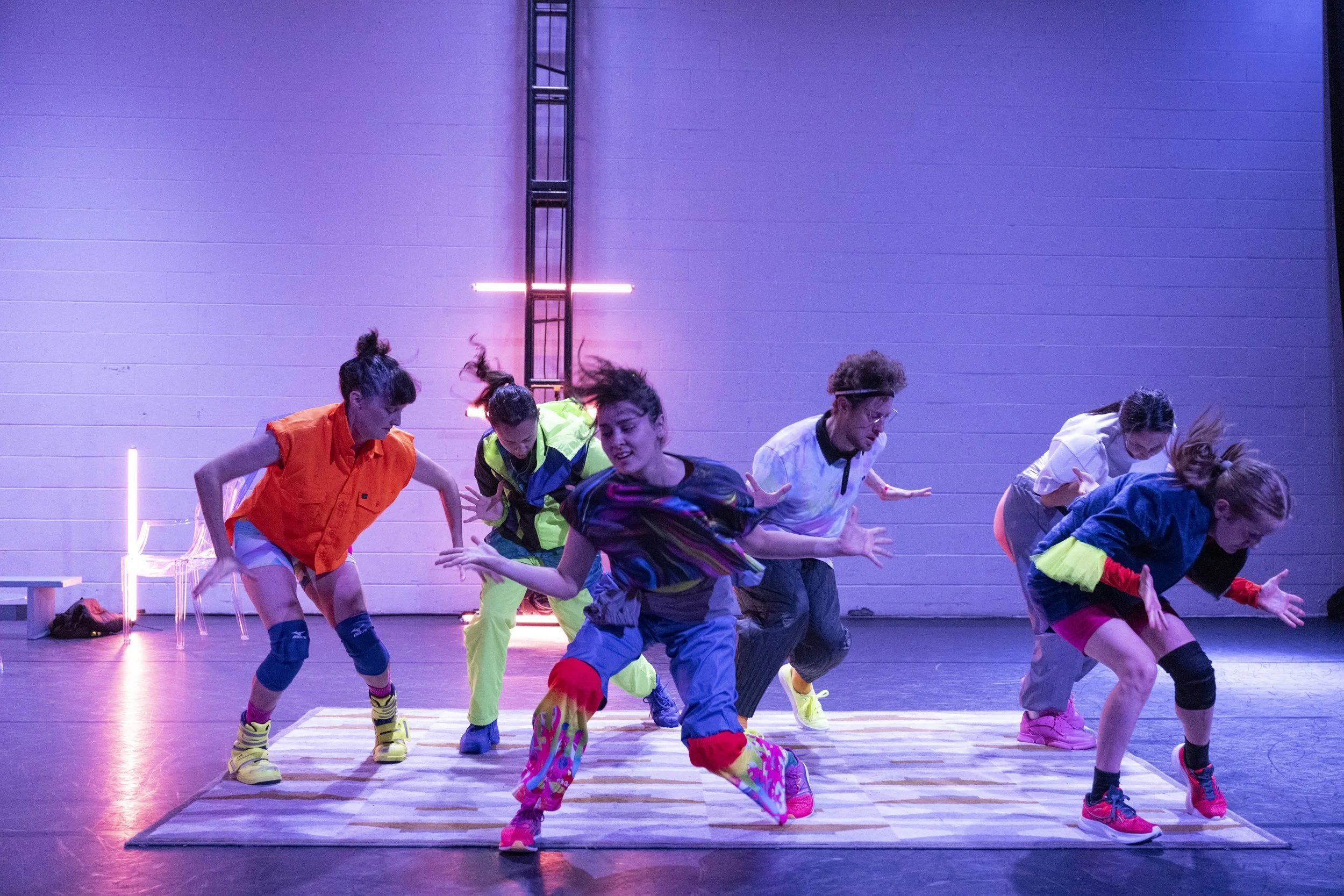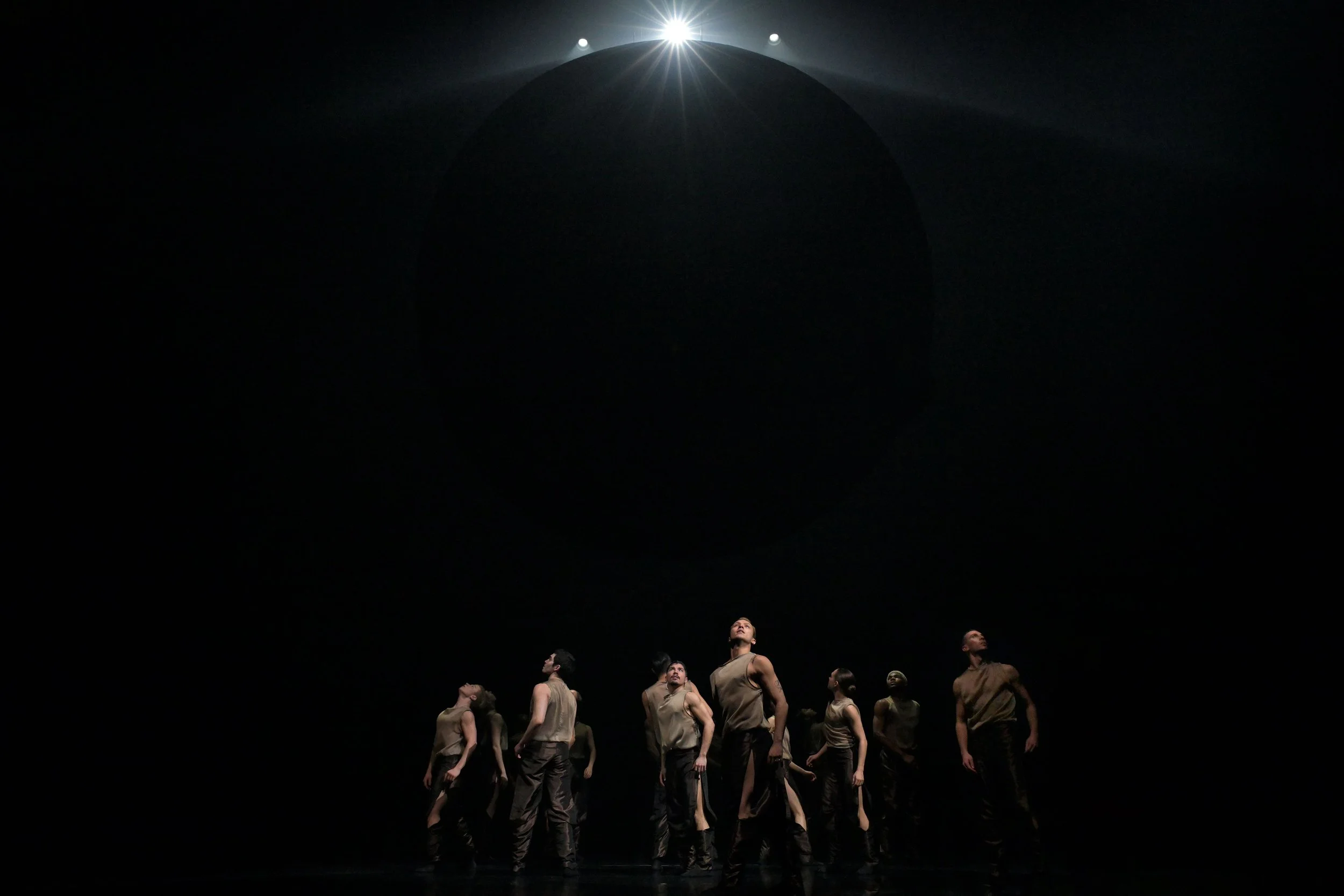Dance review: Bathed in lossy's neon glow, Company 605 dances the infinite scroll
Energized and visually striking, the new Dancing on the Edge-SFU Woodward’s work also alludes to multiple levels of loss
Company 605s lossy. Photo by David Cooper
Company 605’s lossy was at the Fei and Milton Wong Experimental Theatre at SFU Woodward’s from June 12 to 14. Dancing on the Edge continues to June 23
WITH DANCERS CLAD in highlighter-yellow sneakers and rave-issue baggy pants, everything bathed in geometric bars of fluorescent neon lights, lossy looks like it should be a happy work. And there is joy in Company 605’s fresh new piece at Dancing on the Edge. But what makes it so compelling is that it’s rooted in an aching, intangible melancholy that speaks to everything from generational angst to the mind-numbing lure of the infinite scroll.
The visual world is instantly striking—a stark contrast to so much shadowy, dimly lit contemporary dance. The stage is decked out in futuristic, clear-Plexiglas furniture and strewn with glowing, cloud-like piles of plastic sheets. Above and on the walls, James Proudfoot’s masterful bars of light add to the dystopic-kitsch club vibe. But into all this walk dancers (and Company 605 co-artistic directors) Lisa Mariko Gelley and Josh Martin, looking shellshocked, grappling with some unspoken loss as they take their places on an inflatable couch.
As the other dancers arrive (Jade Chong, Kate Franklin, Ruby Henderson, Antonio Somera, and Shana Wolfe) their bodies find the score’s rising housebeat, pulsing together. At first, they crouch with their feet frozen in place, caught in a kind of rhythmic inertia. But suddenly, in lossy’s most distinctive and cleverly metaphorical sequence, their glitching and grooving falls into synch and starts to move the rug they’re standing on—eventually transporting it across the floor. (How do you move forward when you, and the world, are in a state of grief? Maybe it looks something like this.)
The energized, committed corps builds to an ecstatic yet relentless blur of fragmented movement—snippets of viral TikTok dances immediately recognizable as the performers switch endless gears in their bodies. Hands pump in the air; feet shuffle, run, and walk on the spot. Choreographers Gelley and Martin have found a brilliant way to embody that eternal, timesucking scroll. They build a frantic tension that comes from rapid-fire flipping between movement styles. As it builds to physical exhaustion, the piece starts to capture everything about social media’s addictive, and ultimately soul-sucking escapism—the way it holds us and denies us the chance to focus on things that matter. Occasionally, a body will fall out of the grind, a person momentarily losing themselves in thought—and then the beat sucks them in again.
The frenzy and fragmentation build till they inevitably break down, the music becoming a chaotic drone. Ever so gradually, Matthew Tomkinson’s soundtrack then morphs into something approaching the orchestral, the movement and music finding harmony, the humans connecting and supporting one another. The sets transform too, the imagery intimating rebirth and transcendence. Suggesting there may be hope for the future after all, the world slows down and the piece finds an almost spiritual new plane, the group’s action now resembling a strange sacred rite.
It’s exciting to see dance find innovative new vocabularies to speak to issues this urgent and now—to so viscerally express what it’s like to exist in the digital sphere. Though lossy might be a fun, visually entertaining, and unpretentiously cool work, amazingly it allows a range of deep readings. On one level, you might relate to it as a group of humans struggling with the loss of someone they love; but you could also interpret it as people dancing in the face of the loss of youthful hope, the loss of planetary future… Dancing away our sorrow.
The work resonated on another unplanned level of "loss" as well: lossy was created with a residency in partnership with SFU Woodward’s Cultural Programs, a 15-year initiative with wide-spanning coproductions with local arts festivals and organizations. SFU recently announced that will end with this show. (Off the top of this Dancing on the Edge opening event, artistic director Donna Spencer made a plea for SFU to reconsider: “We hope this will resonate with people—that this is an important space for music and dance. We really want this to happen again and want to fill this venue with bodies and arts and other events.”) It goes without saying the closure of the program will mean fewer inspired live creations like this—and, god help us, send us back to the doom scroll again. ![]()














